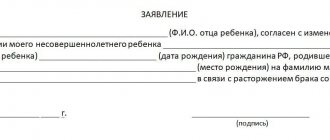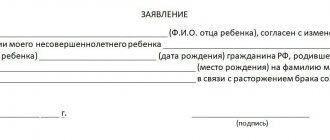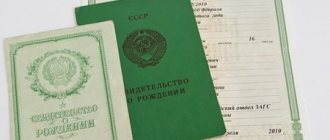A person can change his first, last or patronymic name from the age of 14. However, before reaching the age of majority, such a procedure requires the consent of both parents, guardians or adoptive parents. The exception is situations when a minor is recognized as having legal capacity (for example, got married, works or conducts business activities).
- Form and sample
- Free download
- Online viewing
- Expert tested
FILES
If a person wants to change his name, he should contact the registry office at the place of his registration with an application to change his last name, first name or patronymic.
For your information! This procedure is regulated by the Federal Law of November 15, 1997 No. 143 “On Acts of Civil Status,” namely its articles 58 to 63.
Child's rights to a name
The child’s right to a first name, patronymic and last name is enshrined in Article 58 of the Family Code of the Russian Federation.
A person's full name consists of:
- the name itself;
- surnames;
- patronymic
The child’s right to a name is exercised by entering information about the child’s first name, surname and patronymic into his birth certificate during state registration of birth in the civil registry office.
Parents can name the child by any name by their mutual consent. However, family law establishes a number of restrictions regarding the child’s name.
Thus, the child’s name should not contain:
- numbers and numerals;
- alphanumeric designations;
- symbols;
- swear words;
- indications of ranks, positions, titles.
It is important to know : parents have the right to name their child with a double name, using the “hyphen” sign when forming the name.
At birth, a child receives the surname of his parents. If the child’s parents have different surnames, then they have the right to independently determine what surname the child will have. The law allows a child to be given a double surname, but the first surname will always be the father's surname.
The child is assigned the mother's surname if the child's parents are not married or the location of the father is not established.
Please note : if the parents cannot come to an agreement and choose a surname for the child, then the choice of surname remains with the guardianship and trusteeship authority.
A child's patronymic is assigned by the name of his biological father, regardless of whether the child's parents are married or not.
If the child’s parents are not married or the father’s position has not been established, then the child’s patronymic is assigned at the direction of the mother.
Where to contact regarding payment
All fees must be paid to the state treasury before submitting documents, since the receipt of the payment is included in their list. You can get it at the registry office, where you will contact to change your personal data.
You can make the payment directly as follows:
- on the State Services portal;
- through ATMs and terminals;
- at the cash desk of any bank;
- at the post office.
Please note that in some cases a fee may apply for completing a financial transaction. The most profitable payment method, as already mentioned, is the State Services portal.
Changing the child's first, last or patronymic name
Current legislation establishes that any person has the right to change his name, surname and patronymic.
The procedure and conditions for changing the child’s surname and first name depend on the age of the minor.
The child has not reached the age of 14 years . Before reaching the age of 14, the child’s name can be changed at the request of both parents with the prior consent of the guardianship and trusteeship authority.
Please note : if the child is already 10 years old, then when changing the name and surname, parents must take into account the opinion of the minor.
The guardianship and trusteeship authority gives consent to change the child's first and last name unless it establishes a violation of the rights and interests of the minor.
The child has reached the age of 14 years .
Upon reaching the age of 14 years, a minor child has the right to independently change his name, surname or patronymic with the consent of both parents.
Fee for replacing a driver's license
Another important document that needs to be replaced is a driver’s license. Please note that it is prohibited to drive a vehicle with a license that contains old data, as it is considered invalid. Therefore, the replacement process should be started immediately.
Additionally, read - how to replace a vehicle passport when changing your last name
The cost of traffic police services for issuing new documents tends to constantly change upward, and therefore it would not be superfluous to clarify the amount of the contribution in advance. Currently, the state duty when changing rights is 2,000 rubles. You will have to pay 3,000 rubles for the rights to a new model with a chip. From January 1, 2021, when paying through the Public Services Portal, you can receive a 30% discount. Thus, new rights will cost 1400 or 2100 rubles, respectively.
Parents' consent to change the child's first and last name
The consent of both parents when changing the child’s first and last name is mandatory in the following situations:
- the parents are married and jointly exercise parental rights in relation to the child. In this case, both parents equally fulfill the responsibilities for raising and supporting the child, respectively, the two of them make important decisions in the life of a minor child;
- The child’s parents are not married and live separately, but both exercise parental rights in relation to the child. The dissolution of the parents' marriage does not relieve the parent living separately from the child from fulfilling parental responsibilities. If one of the parents does not live with the child, but at the same time properly fulfills parental responsibilities, then he has the right to take part in the life of the child. Therefore, in the event of a divorce, in order to change the child’s surname and first name, the parent who wants to change the child’s name must obtain not only the permission of the guardianship and trusteeship authority, but also the consent of the second spouse;
- the child reaches the age of 14 years. Upon reaching the above age, the child has the right to independently express a desire to change his first and last name, but only with the permission of both parents.
When a child turns 18, he gains full legal capacity and becomes an adult. From this moment on, the child has the right to independently exercise the full range of rights and not ask the opinion of his parents when making decisions about his life.
Please note : in certain circumstances (such as marriage or emancipation), a child may become an adult before reaching the age of 18. If a child becomes an adult, he has the right to independently manage his life.
Upon divorce, the parent living separately from the child is obliged to fulfill his parental responsibilities for the upbringing and maintenance of the minor. If a parent does not properly fulfill his parental responsibilities, then the second parent, who has expressed a desire to change the child’s first or last name, has the right not to obtain consent from the second parent.
It is not necessary to obtain consent from the parent in the following cases:
- it is impossible to determine the location of the parent. If a parent, after the divorce, does not maintain contact with the child and his whereabouts are unknown, then the second parent has the right not to obtain consent from him to change the child’s name or surname;
- deprivation of parental rights. In case of deprivation of parental rights, the parent loses the rights to raise the child and communicate with him, therefore the parent has the right not to ask the opinion of such a parent on changing the name of the child;
- the court declares the parent incompetent. An incapacitated parent cannot be responsible for the actions taken and the consequences of the decisions he has made, therefore consent from such a parent to change the name is not required;
- failure by a parent to exercise parental rights. Sometimes a parent after a divorce may not fulfill his parental responsibilities until he stops communicating with the child. In such a situation, the second parent has the right not to take his opinion into account when making decisions regarding the child’s life.
Also, the consent of the second parent to change the child’s surname is not required if the child’s parents were not in a registered marriage and paternity has not been legally established.
Refusal to issue
Civil registry office employees may refuse an applicant and have the right to do so.
The conditions for refusal or permission are not prescribed by law; the civil registry office determines them independently. You will be refused if you have chosen to replace the data of a famous media or historically famous personality, political figure, noble family, or chosen the name of a product, product, historical monument or city.
Before changing the surname in your passport to the one borne by someone close to you, the relationship must be documented.
To use the data of a biological father about whom there is no information, a certificate confirming paternity may be required.
Attention! A list of reasons for changing personal data can be provided at the registry office.
Procedure for changing a child's first and last name
To change the child's first and last name, the parent must first obtain the consent of the guardianship and trusteeship authority. To obtain consent, the parent submits an application for a name change to the guardianship authority.
The parent must attach the following documents to the application:
- parent's identity document;
- child's birth certificate;
- certificate of marriage and divorce (if available);
- consent of the parent to change the child’s surname if only one parent applied to the guardianship and trusteeship authority. It should be noted that in this case, the guardianship and trusteeship authority may require a document from the parent confirming that there is no need to obtain consent from the second parent (for example, a court decision declaring the second parent incompetent).
The above list is approximate, since the legislation does not contain provisions on the necessary attachments to the application.
After receiving the appropriate consent, the parent applies to the registry office to change the child’s first or last name.
Important to know : parents must contact the registry office at the place of registration of the child or at his place of residence.
When registering a change of first or last name with the state, the parent must pay a state fee in the amount of 650 rubles.
In the application, the parent must indicate the following:
- personal data of the parent submitting the application and the minor child;
- information contained in the child’s birth certificate;
- last name, first name or patronymic to which the parent wants to change the existing name, as well as the reasons for such a change;
- date and signature of the parent.
The parent must attach the following documents to the application:
- child's birth certificate;
- marriage certificate of parents and divorce certificate of parents (if available);
- consent to change the name, surname or patronymic from the guardianship and trusteeship authority.
The registry office considers the application within one month from the date of its receipt.
When changing the name, the parent is issued a certificate containing the following information:
- surname, name, patronymic before and after their change;
- information about the child (date and place of birth of the minor and his citizenship);
- the date of preparation and record number of the act of change of name, as well as the date and body of the registry office that issued the document.
After changing the child's first or last name, the parent is issued a new birth certificate.
Getting a new SNILS
When changing personal data, it is also mandatory to change SNILS. This procedure involves replacing personal data in the pension certificate. The number itself, as in the previous case, remains unchanged, since it is also assigned to each citizen forever.
If the applicant is officially employed, this function will be taken over by his employer. If not, you can contact the Pension Fund yourself. To do this you need to provide:
- A document that can confirm a change of surname. For example, a marriage certificate.
- Passport.
- Old SNILS.
There is also no state duty charged when changing SNILS.
Cost of services
Information about what documents are needed to change a surname can be obtained from the authorities responsible for replacing or making adjustments.
How much does it cost to change a passport ? The amount that you will have to pay for the certificate of change is 1,600 rubles.
The state duty is 300 rubles. As a result, you have to spend a little less than 2,000 rubles. The process of replacing a document can be “started” without leaving home, because change your last name online through “Government Services”.
This requires:
1. Go through the registration procedure and confirm your identity using the suggested methods.
2. Go to the “Replacement of Russian passport” category.
3. Fill out the form on the portal, click “GUVM MIA”.
4. Wait for a call to the selected authority (a message that you need to come at a certain time will come along with a check to pay the state fee).
5. Pay the fee.
6. Arrive at the appointed time to pick up your passport.
Updating other documents
Sometimes people do not want to change their passport data because after receiving another passport they have to update some other documents, for example, a compulsory medical insurance policy, an individual tax number.
Some documents do not need to be changed, but information should be included in them that the information of their owner has changed.
These include:
- PTS,
- bank accounts (you need to change the details in the details),
- employment history,
- student ID, grade book (for students).
- a number of documents: a diploma of higher or secondary education.










